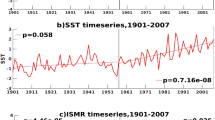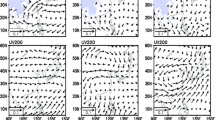Abstract
By comparing different climatologies in El Niño decaying summer with regard to the presence of Indian Ocean Basin (IOB) warming, we studied the effect of IOB warming on the Northwest Pacific sea surface temperature (SST) anomalies and the coupling process with the surface wind. Zonal asymmetric coupling feedback in the west and east of the Northwest Pacific were caused by the asymmetric spring–summer transition of the background tropical atmospheric circulation. Although the westward wind anomaly caused by the remote effect of IOB warming is found in the whole Northwest Pacific, reversal of the mean background surface winds in the western part leads to negative wind-evaporation SST (WES), whereas sustained trade winds lead to positive WES in the eastern part. The east–west SST gradient resulting from this zonal asymmetric evolution of SST sets off more positive feedback that strengthens the local anticyclone easterly anomalies.




Similar content being viewed by others
References
Annamalai H et al (2005) Impact of Indian Ocean sea surface temperature on developing El Niño. J Clim 18:302–319
De Szoeke D et al (2007) What maintains the SST front north of the eastern Pacific equatorial cold tongue. J Clim 20:2500–2514
Du Y, Xie S-P (2008) Role of atmospheric adjustments in the tropical Indian Ocean warming during the 20th century in climate models. Geophys Res Lett 35:L08712. doi:10.1029/2008GL033631
Du Y et al (2009) Role of air–sea interaction in the long persistence of El Nino-induced North Indian Ocean warming. J Clim 15:2023–2038
Emanuel K et al (1997) Reply to comments by Bjorn Stevens, David A. Randall, Xin Lin and Michael T. Montgomery on ‘On large-scale circulations in convecting atmospheres’. Quart J R Meteorol Soc 123:1779–1782
Fu C, Teng X (1988) The relationship between ENSO and climate anomaly in China during the summer time. Sci Atmos Sin 12:133–141
Harrison D, Larkinn NK (1996) The COADS sea level pressure signal: a near-global El Niño composite and time series view 1946–93. J Clim 9:3025–3055
Kalnay E et al (1996) The NCEP/NCAR 40-year reanalysis project. Bull Am Meteorol Soc 77:437–471
Kawamura R (1998) A possible mechanism of the Asian summer monsoon–ENSO coupling. J Meteorol Soc Jpn 76:1009–1027
Klein SA et al (1999) Remote sea surface temperature variations during ENSO: evidence for a tropical atmospheric bridge. J Clim 12:917–932
Smith TM et al (2008) Improvements to NOAA’s historical merged land-ocean surface temperature analysis (1880–2006). J Clim 21:2283–2296
Tao S, Zhang Q (1998) Response of the East Asian summer monsoon to ENSO events. Sci Atmos Sin 22:399–407 (in Chinese)
Wang B, Zhang Q (2002) Pacific-East Asia teleconnection. Part II: How the Philippine Sea anomalous anticyclone is established during El Niño development. J Clim 15:3252–3265
Wang B et al (2000) Pacific-East Asia teleconnection: how does ENSO affect East Asian climate? J Clim 13:1517–1536
Wang B et al (2005) Fundamental challenge in simulation and prediction of summer monsoon rainfall. Geophys Res Lett 32:L15711. doi:10.1029/2005GL022734
Wu B et al (2009) Contrast of rainfall-SST relationships in the Western North Pacific between the ENSO-developing and ENSO-decaying summers. J Clim 22:4398–4405
Xie P, Arkin PA (1996) Analyses of global monthly precipitation using gauge observations, satellite estimates, and numerical model predictions. J Clim 9:840–858
Xie S-P et al (2009) Indian Ocean capacitor effect on Indo-Western Pacific climate during the summer following El Niño. J Clim 22:730–747
Yang J et al (2007) Impact of the Indian Ocean SST basin mode on the Asian summer monsoon. Geophys Res Lett 34:L02708. doi:10.1029/2006GL028571
Zhang R et al (1996) Impact of El Niño on the East Asian monsoon: a diagnostic study of the ’86/87 and ’91/92 events. J Meteorol Soc Jpn 74:49–62
Acknowledgments
This work is supported by the National Natural Science Foundation of China (40906005; GYHY201106017); the National Key Program for Developing Basic Science (2010CB428504); and the National Key Technologies R&D Program of China under Grant 2009BAC51B01.
Author information
Authors and Affiliations
Corresponding author
Rights and permissions
About this article
Cite this article
Hu, H., He, J., Wu, Q. et al. The Indian Ocean’s asymmetric effect on the coupling of the Northwest Pacific SST and anticyclone anomalies during its spring–summer transition after El Niño. J Oceanogr 67, 315–321 (2011). https://doi.org/10.1007/s10872-011-0039-y
Received:
Revised:
Accepted:
Published:
Issue Date:
DOI: https://doi.org/10.1007/s10872-011-0039-y




